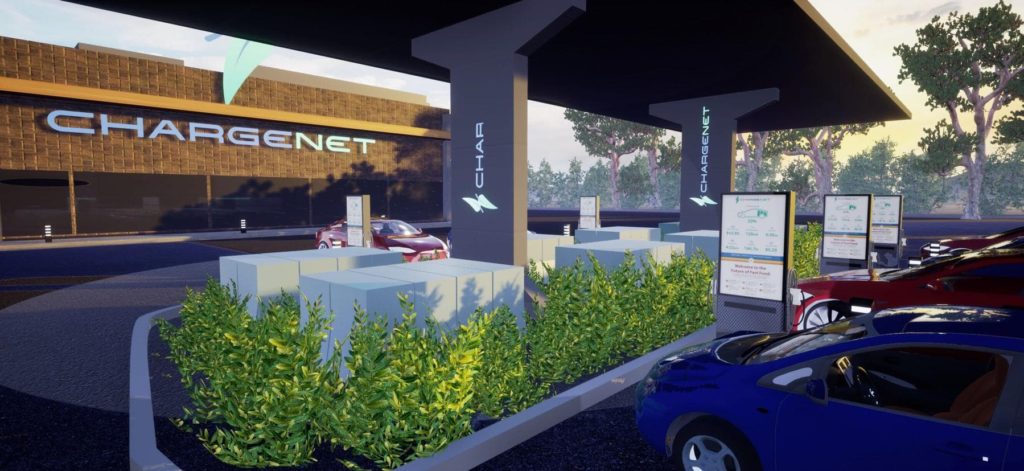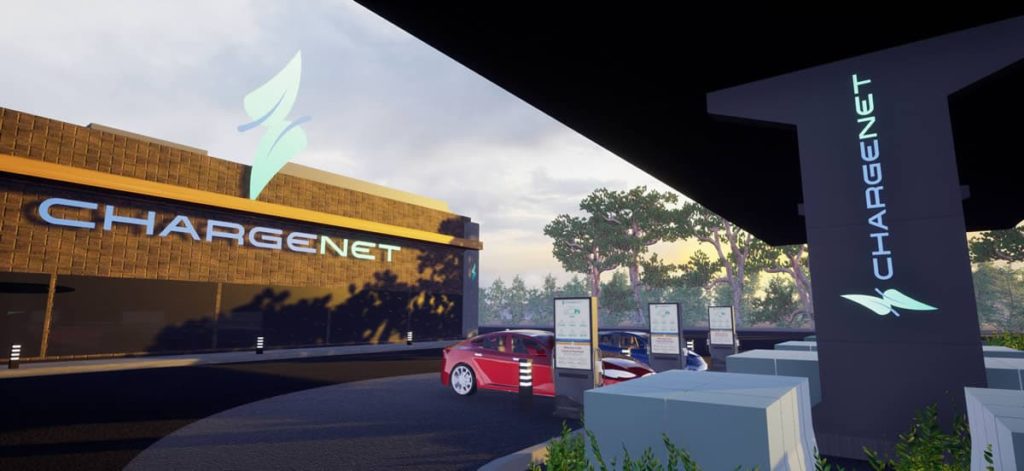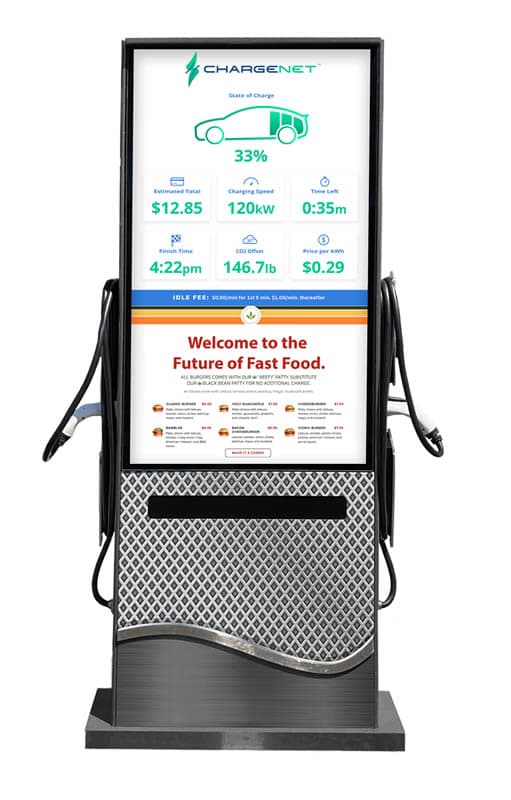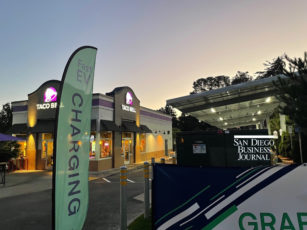Move over truck stops: “convenience” EV charging depots will deliver electricity and food — powering cars and people at the same time : HOMER Microgrid News
California-based ChargeNet is creating a network of fast-charging stations across the state to meet the exponentially growing EV market and the demand for charging infrastructure that will go with it. DC fast-charging stations currently only make up 14% of the public EV charging station market, and many analysts estimate that EV owners will be content for the foreseeable future with home-based Level 2 “trickle charging.

But, ChargeNet CEO Tosh Dutt is betting that the fast-charging market will be vastly underserved within the next few years — notwithstanding a 2020 slowdown due to COVID-19. To meet the expected demand, he’s developing charging stations along major California transportation corridors that will combine access to sustainably minded “fast-casual” and “quick-serve” restaurants with fast-charging services powered by distributed renewable energy. Some stops might add retail shopping to the equation.
“Americans want convenience,” Dutt says “and they are impatient. They will want to go shopping and eat out while their cars are charging. They want a dynamic experience.”
ChargeNet uses HOMER Grid to design its new charging depots
A HOMER Energy by UL partner, ChargeNet is testing the new EV charging station design feature in HOMER Grid software to create a new product called the Kit-As-A-Service solution that will simplify the creation of modular EV depots powered by solar PV and battery storage. They are using HOMER Grid to model the energy demands of these systems, both as independent charging facilities and as entire depots including restaurants and/or shops.
HOMER Grid simulates the engineering and financial performance of dozens of distributed energy systems simultaneously and identifies the most economically optimal configuration. It also provides calculations on capital and operating costs and payback times.
The solar PV will be supplied by CED Greentech. By using high-efficiency bifacial panels wherever space is constrained, the solar arrays will be deployed in the form of canopies or car ports that provide shelter for the charging bays while generating the energy to power them. The solar canopies will also signal to passing drivers that the charging station is renewably powered, which is likely to be a strong selling point with the electric vehicle owners, many of whom choose EVs for environmental reasons.

The fast chargers will be supplied by Enel X, and each ChargeNet system will include battery storage so that excess solar production can be captured during the day and released when solar is unavailable. The batteries will also allow the ChargeNet stations to optimize their financial performance, using stored battery power when utility rates are highest and the sun when PV production is at its peak. Finally, the Charge Net stations will be built so that they can be islanded from the main electric grid and continue to provide service to customers in case of a power outage.
ChargeNet’s ChargeOpt software integrates DC fast-charging, retail point of sale services and energy management
ChargeNet’s ChargeOpt software, which utilizes artificial intelligence (AI), will integrate and manage the charging station to maximize the use of clean, renewable power and reduce utility bills and operating costs. The software will also manage billing, digital advertising on its displays, restaurant and retail point-of-sale, and charging station locations will be incorporated into its network app. It will have voice recognition so that drivers will be able to order charging services and food – all without touching a single screen, a feature Dutt calls the pandemic proof “car hop model.” All software updates will occur wirelessly as various devices connect to the cloud.
AI software is capable of “learning,” so as it is used, the ChargeNet software will become increasingly adept at using point-of-sale data to schedule and dispatch energy assets in the most efficient and cost-effective manner. Dutt says his EV charging stations will help reduce grid congestion. The software will also be designed to forecast electricity loads and provide grid services for utilities including load management or demand response and allocation of carbon credits.

Why do we need fast-charging when there are still so few EVs that require it?
ChargeNet says that EV infrastructure isn’t keeping up with market growth and estimates serious shortages of charging infrastructure within the next few years, especially for fast-charging. According to a report issued last year by Environment California, there is an urgent need for more access to public charging stations:
· A Union of Concerned Scientists survey reports that only slightly over half the California population has access to off-street parking with accessible electric plugs. People who live in compact urban areas or multi-family housing will have to rely on public charging if they want to drive electric vehicles.
· California does not now have enough public charging to support the number of EVs on the road, and by 2030 the shortage will become even more acute. It’s estimated that by 2030, the state will need approximately 180,000 Level 2 plugs and 35,000 fast charging plugs to support the state’s goal of 5 million zero-emission vehicles. There is already a shortage of fast-chargers, with only 2,500 plugs while 3,600 are needed.
· EV drivers face a challenge from the proliferation of proprietary networks, which often require membership or specific apps to use equipment. California currently has nine different networks.
ChargeNet’s ChargeOpt will be able to take payments from all major credit cards and payment methods at the kiosk. The company will have its own network app that will reconcile payments via near field communication (NFC) and Bluetooth.
ChargeNet plans construction of 20-25 locations in the next three years
ChargeNet is currently finalizing supply chain agreements as well as its first restaurant contract, and expects the first location to be completed by the end of the year. If all goes according to plan, the first ChargeNet depot will be open for service in Southern California by the end of the year.

UL’s HOMER Grid is a market-leading solar-plus-storage software tool for designing grid-tied distributed energy systems. With an integrated North American utility database and a new module for electric vehicle charging stations, it optimizes peak shaving to help commercial and industrial utility customers lower their demand charges. HOMER Grid can model projects with wind and combined heat and power as well as islanded systems, helping users improve their resiliency. Explore your opportunities with HOMER Grid during a complimentary trial. Download it now.
Discover how modeling EV Charging is key to the future at the 8th Annual HOMER International Microgrid Conference, October 12-16, 2020. In this presentation — Industrial Microgrids for Energy Savings: Using available generation assets to reduce utility spec — MTU/ Rolls Royce’s Tom Drake, senior sales manager, will demonstrate how modeling EV charging helped an industrial company install a distributed generation system to lower the demand charges and allow their company to shift to normal 7am to 3pm work schedule.
Attendance is free and sessions are 100% online from October 12-16. For more information or to register, visit the HOMER International Microgrid Conference website.


